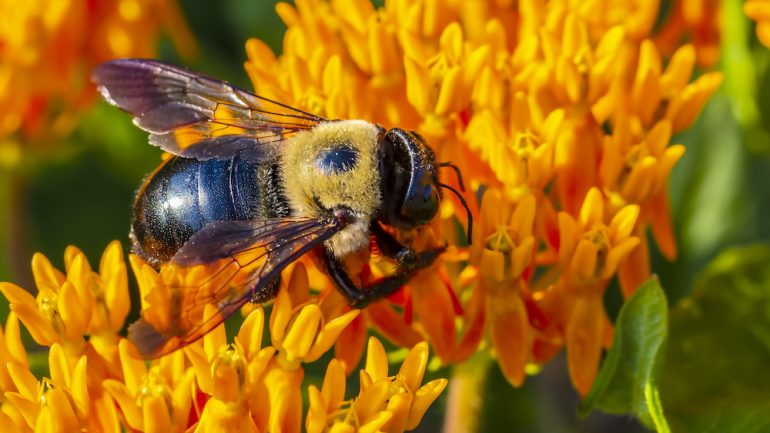When it comes to carpenter bees, homeowners tend to fall into one of two camps: those who see the giant bees as a menace and those who see them as pollinators.
They can be both
Carpenter bees, if you’ve yet to encounter one, are large and resemble bumblebees. Like bumblebees, they are great to have in the garden to pollinate your plants. Unlike bumblebees, they have a shiny black tail. They also like to burrow into wood, hence their name. And that’s what gives them a bad reputation.
The females drill perfectly round holes into wood, making tunnels for their nests. Even treated and painted wood isn’t safe once a carpenter bee decides to move in. Nor do the bees stop at decking, eaves or siding; wooden porch furniture isn’t safe from them either.
Carpenter bees start appearing in April and May; take note of the droning and aggressive behavior. They sound alarming but the male carpenter bees, which are the ones thumping their chests, don’t have stingers. Females do, but tend to sting only when agitated, so don’t swat at one.
Signs you have carpenter bees
In addition to their noise, carpenter bees leave a calling card of sawdust and yellowish brown stains on the wood around your home. Most of their activity ends after a few weeks as the females die soon after taking care of their eggs. You’ll see a second round of activity in late summer when the next generation emerges from the tunnels. The new bees will enjoy the flowers of late summer before going back to their tunnels for the winter.
While all this tunneling sounds alarming, it would take years for carpenter bees to do real damage to your home. Still, they can lead to problems: bee-infested wood can attract woodpeckers, and rain-soaked wood can lead to fungus or more bugs, such as carpenter ants. If that happens, call a pesticide professional to deal with the ants.
What to do if you see damage
If you must get rid of the carpenter bees, hire a pesticide company to apply a pesticide directly to each hole and seal with aluminum foil, then caulk after 24 hours to give the bees time to get back inside.
You could also just plug the tunnels and not use pesticide, but a good bee will simply chew an escape route. A better option is to leave them alone. They’re pollinators after all.
Related – Creepy Crawlies and Critters Can Damage Your Yard


